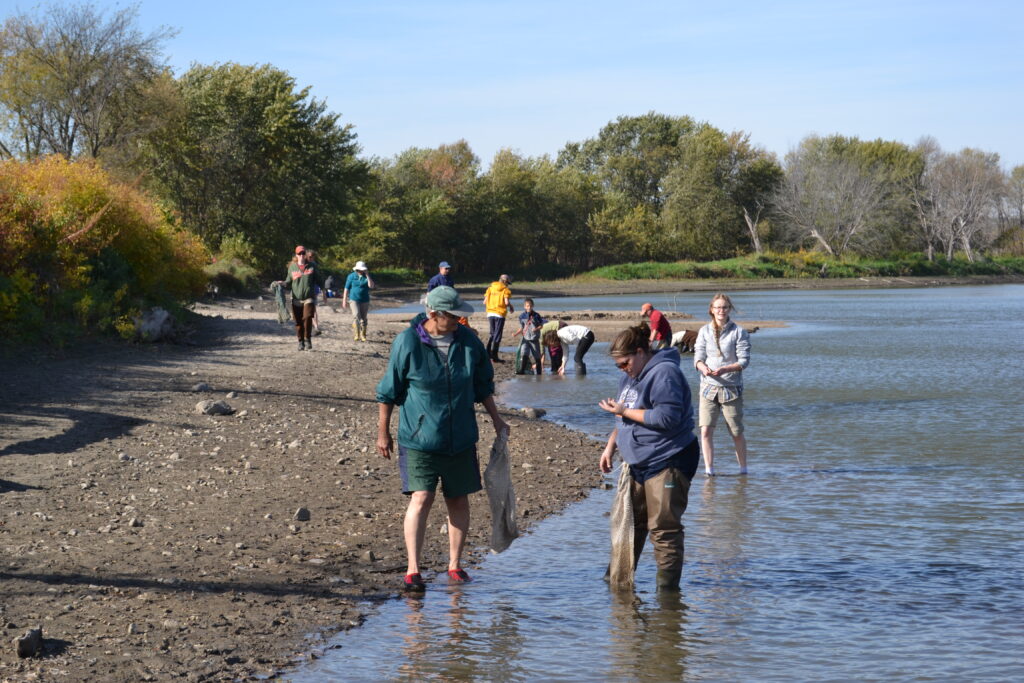There is only one thing better than a beautiful fall weekend where the air is crisp and the sun warms your face, it is the opportunity to get your feet wet while hunting for the jewels of the Minnesota River: freshwater mussels.
It was a beautiful fall day on the Minnesota River near the confluence of the Yellow Medicine River where 11 teachers gathered on Friday, October 9th, to learn about the value and importance of freshwater mussels from Bernard Sietman, a malacologist with the Minnesota Department of Natural Resources (MN DNR). The workshop on Friday was the first collaboration that the Minnesota River Valley Education District (MRVED) and CURE partnered on to engage teachers in learning more about the river ecosystem.
The day started off with a presentation at Yellow Medicine East High School to learn about the anatomy of mussels, how they reproduce and sustain themselves over the years. Sietman talked about using mussels to determine the health of a river system. Mussels are parasitic and need primarily fish in order to reproduce. Most mussels are species specific in selection of a host fish for reproduction. Mussels play a key role in aquatic environments and are considered to be “ecosystem engineers” because they modify aquatic habitat, making it more suitable for themselves and other organisms.

After a basic overview and a brief discussion on the history of mussels, the group set out for the Upper Sioux Agency State Park to break out the waders and boots. The group was eager to get their feet wet and after about two hours of scouring the river the group gathered to share their treasures. Much to Sietman’s surprise, the group was able to identify 9 different species of live mussels as well as remnant shells of other species found in the Minnesota River. The most prolific finds that day were the Deertoe and the Threehorn Wartyback. Fresh Deertoe remnant shells were found on the sand that a lucky muskrat feasted on earlier that morning.

On Saturday, October 10th, CURE hosted its 3rd Annual Mussel Field Day with Sietman. The participants ranged in age from 7 to 72 and everyone found something to get excited about. There were families, college professors, K-12 teachers, college students and for many, this was their first exposure to mussels but for about a dozen of the near 30 participants, this was their third mussel field day experience. Sietman affectionately refers to these mussel enthusiasts as “mussel nerds.” As he chuckles he reports this as a rare phenomenon only found here in southwestern Minnesota. Saturday’s weather was not as friendly as the previous day, but a little wind and cooler temperatures did not keep the “Mussel Enthusiasts” back from jumping in and getting their feet wet. Some were a bit reluctant but once the first person yelled “I found a live one!”, there was no holding back. Over 70 live mussels were discovered with 11 different species identified.

North America is home to some 300 live species of mussels with just short of 50 different species found in the Minnesota River. All live mussels were returned to the river following each of the field days and participants were informed of the laws that govern the protection of mussels. Sietman also covered the MN DNR policies and laws regarding individual’s ability to possess remnant shells.
Special thanks to Bernard Sietman from the MN DNR for presenting on both Friday and Saturday, Yellow Medicine High School for hosting the classroom presentation on Friday and for the Minnesota River Valley Education District for bringing together teachers from five different school districts to learn more about the Minnesota River ecosystem.

Blog post and photos by Peg Furshong, Director of Operations & Constituent Relations.


